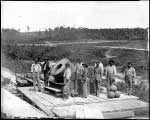

|
Photographs Click on the thumbnail image to view a larger picture. Answer the questions below by examining each photograph. The Photo Analysis Guide provides further guidance. Examine the photographs below. Answer these questions:
|
One easy way to create your own primary source is to take a photograph. Be as creative as you want—choose a theme or simply take a random shot. Some Ideas ... 1. Photograph a building that is architecturally interesting. You might want to create a scrapbook, computer slide show, or Web page tour of buildings in your community. 2. Have students create an autobiographical stamp or trading card using a self portrait. 3. Taking a field trip to the zoo is a great way to introduce photography and learn about animals at the same time. Zoo animals are wonderful candidates for pictures. Many will "perform" for the audience. 5. Have your students explore the "hidden" world around them by having them locate and photograph lines, shapes, and angles. You will be fascinated by the variety that can be found. This could be incorporated into a math lesson. 6. What makes a city vibrant? Main Street USA, especially in cities, is generally a hive of activity during the lunch hour. Students can photograph all sorts of interesting people, objects, and signs. Pick photos from each student's portfolio to form an exhibit of City Life or Cityscapes. 7. Create a time capsule of photographs to document the current year. Hand the time capsule down to a class that will open it in five or ten years or donate it to the local historical society. You might want to involve senior citizens in this project. Let's take a peek behind the scenes at The Library of Congress in the Prints and Photographs Division with one of the curators. |
||||||||||||||||||||||||
|
||||||||||||||||||||||||||
© 1996 - 2011 Linda C. Joseph
All Rights Reserved
All CyberBee Graphics are Trademarked
Graphics by
Darlene Vanasco/Creative Director
Erika Taguchi/Designer & Illustrator
Hosting Provided by Iwaynet










